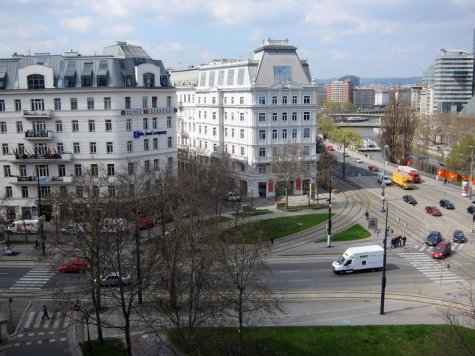My hotel room overlooked Julius Raab Platz (in honour of a Federal Chancellor of Austria in the 1950s) by Uraniastrasse (near the observatory).
A grocery store was conveniently nearby, where I picked up foods for breakfast.
Gary and I wended our way southwest through Vienna, by the Dominican Church on Postgasse.
At the edge of the city core, the Johannes Gutenberg Monument is at Am Lugeck.
We walked through Stephansplatz — the geographic centre of Vienna — and continued south.
Continuing down Krugerstrasse, we passed the Opera House.
The Naschmarkt presented a wide variety of choices for lunch.
Produce was well presented, as expected in most European markets.
The bottles and casks might have suggested wine, or olive oil, but turned out to be a display for the vinegar store.
Retracing our path north, we had more time to enjoy St. Stephen’s Cathedral.
Since Gary and I are actually enjoy a workout, we ascended the 343 steps up.
Not quite to the top is a gallery, with windows to the exterior.
From the top, the view east revealed a few modern buildings. The other directions had mostly traditional rooftops.
On the way back to the hotel, the City Bikes rental at Schwedenplatz were an attractive option that I didn’t take.
The trams seemed to be a more practical alternative for the few days in Vienna.
The next day, we went to the University of Vienna, where the 20th EMCSR meetings were underway.
Upstairs in the Main Building, the hall of statues was grand, although vacant of students during the holiday period.
Opting for sightseeing in the afternoon, the Austrian Parliament Building was on the way to the Museum Quarter Wien.
The linearity and grey brick of the MUMOK — Museum of Modern Art — is a contrast to the more traditional architecture in Vienna.
The installation of “20 Cedar Slants 20 degrees” by American Carl Andre (1990) was modern, yet organic.
The installation of Mike’s House (1982) by American artist Mike Smith was part of a major exhibit.
It’s sometimes hard to judge whether to touch or not touch art objects. A tour converging by an installation with sofas was a surprise.
A floor sculpture “Weider Bei Null Anfangen” (2001) — Starting Again at Zero — by Simone Westerwinter required some explanation. “A cooling unit mounted on top of a metal plate makes the water below it form a thin layer of constantly changing ice on the surface” in homage to founder of the European Zero movement.
Leaving the MUMOK, we wandered some more through the Museum Quarter and Maria-Theresien-Platz, before wending our way back to the trams.
With many of the group coming from Vienna to the IFSR Conversation, we arranged for taxis to take us to Kloster Pernegg.
The chapel did have a service on Sunday, but I didn’t attend. The cemetery presumably is maintained for the village of Pernegg nearby.
The seminar rooms of the converted monastery are in a building across the courtyard from the hotel rooms.
Outside the main courtyard, an outer wall overlooked a forest and a stream.
The way down had an unpaved road that circled the property.
By the stream, we found some ruins of a wall.
At one time, there must have been a pool, or reservoir.
Today, there’s just a stream with water flowing peacefully by.
The shortest walk back to the monastery was steeper than the way down.
Since I travel to a lot of cities, Vienna is a place that I was probably bound to encounter sooner or later. An Austrian monastery is a less likely destination, but a good opportunity for low distraction conversations amongst researchers for a few days.
[Start a large-image lightbox screen show over this blog post (in a supported browser)]
[See the album of 54 Vienna-Nachtmarkt-StStephans webphotos (with a slideshow option)]
[See the album of 7 Vienna webphotos (with a slideshow option)]
[See the album of 48 Vienna-MuseumQuarter webphotos (with a slideshow option)]
[See the album of 80 Pernegg webphotos (with a slideshow option)]




































